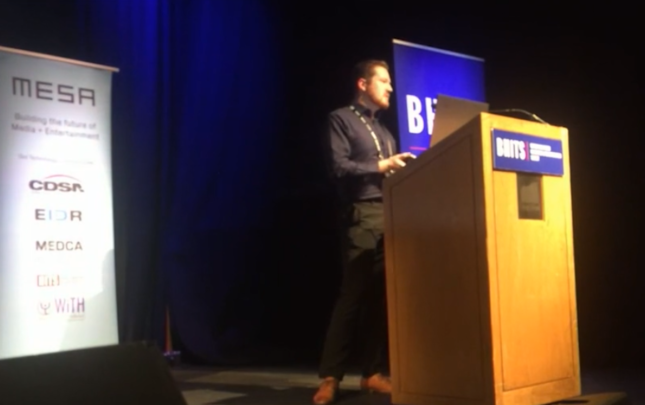M+E Connections

British HITS: An Industry Analyst’s Take on Virtual Production
Story Highlights
Before the pandemic, the term virtual production was little discussed let alone implemented but, fast forward two years, and the world is a very different place now.
If nothing else, the pandemic taught us that a lot of work can be achieved remotely and that technological change can happen at breakneck speed when it has to. But, for virtual production to continue its growth trajectory, there remains a huge learning curve the industry still must climb.
“Why is an analyst perspective interesting when we talk about virtual production?” Chris Evans, head of pro video at Futuresource Consulting, asked rhetorically at the start of the networking luncheon session “Virtual Production – An Industry Analyst Perspective” at the Nov. 15 British Hollywood Innovation & Transformation Summit (HITS) event in London.
“Well, firstly, at Futuresource, we work with a number of different technology companies across the entire video content supply chain,” he said. “So we have dedicated teams working on B2C and B2B devices across a range of different vertical applications.”
Evans went on to discuss the key trends and developments that are taking place in the media and entertainment industry now and what the future roadmap looks like.
“You can see there from our portfolio of expertise, we’re already engaged with a number of the companies that are producing some of the technologies that are involved within the creation of kind of virtual production pipelines [and] also the distribution of content and then ultimately looking at the consumption of that,” he told attendees.
“We like to call this kind of a glass to glass view,” he noted, adding: “I myself work in broadcast and professional video sits at the beginning of that supply chain – so at that very first piece of glass, whether that’s the camera lens, the content creation piece. And … this has been a really exciting area to explore because this is a place of kind of pure innovation.”
 He told attendees: “For the past couple of years, this has been a real key topic we are being asked about by our clients as to what are the needs for virtual production? How is this influencing our technology roadmap?”
He told attendees: “For the past couple of years, this has been a real key topic we are being asked about by our clients as to what are the needs for virtual production? How is this influencing our technology roadmap?”
Across his firm’s B2B services, “we have two key kind of columns that relate specifically to virtual production, where it is kind of now professional displays,” he pointed out, noting: “We have a dedicated team looking at this and LED manufacturing has kind of been a key area that relates to this. And then myself, heading up pro video, you can see a range of different areas…. We work with many of the leading camera manufacturers, kind of in a global capacity, looking at how these technologies are evolving.”
The company also looks at “live production hardware as well, some of the kind of cloud-based systems as well in terms of production infrastructure,” he said. “So the bit we’re all kind of waiting for, you know: virtual production.”
He proceeded to try and do away with “some misconceptions,” he told attendees. “I think when we say virtual production at the moment, maybe quite a lot of people generally gravitate towards thinking about the LED volume concept and workflow that’s been kind of pioneered by Industrial Light & Magic and stagecraft on The Mandalorian, but has now become iterated and used in a range of different use cases.”
However, he explained: “It is more than just the kind of LED volume type use cases. What’s really interesting as well though, is with this technology, it’s moved at a kind of a rate of change that’s been really significant over the past couple of years…. This workflow has been proliferated through a number of different vendors providing rental solutions on different sets, on different productions, things like that.”
He went on to say that production companies don’t need to do a whole production on a virtual stage or with LED volume,” explaining: “The best results are going to be where it’s brought into pre-production. It’s a consideration. So really we should think about this as another tool in our arsenal for content production.”
Questions that need to be asked include: “Where would we be benefiting from using LED volumes? Where would we be benefiting from actually doing this one on location? Because the amount of assets we’d have to generate is just too significant” in some cases, he said.
“We’re still in the early stages but we are seeing more collaboration between departments from these different industries, from game design, from traditional cinema acquisition and from the LED kind of event space coming together,” he told attendees.
“This is really, really key to build kind of common training resources,” he noted. “Some people say, ‘perhaps it could be a bit of a wild west out there and you kind of go on one volume and then you go to another one for another company.’”
“It’s kind of very different to your experience so bringing those kind of workflows together is quite important for continuity,” he pointed out.
“And then also, looking down market, there is that continued opportunity for wider vertical usage as the kind of the service availability matures within rental channels and the freelancer pool,” he added.
To view the entire session, click here.
To download the presentation, click here.
The British Hollywood Innovation & Transformation Summit, held in conjunction with the EIDR Annual Participant Meeting, was sponsored by Whip Media, GeoComply, Perforce, Signiant, and EIDR, was programmed under the guidance of the content advisors of the Hollywood IT Society, and was produced by MESA and the Hollywood IT Society (HITS).









